PREVIOUS
Economic Survey 2021
February 11 , 2021
1535 days
5504
0
- The Economic Survey of India is an annual document released by the Ministry of Finance.
- It contains the most authoritative and updated source of data on India’s economy.
- It is prepared by the Economics Division of the Department of Economic Affairs in the Finance Ministry under the overall guidance of the chief economic adviser.
- The first Economic Survey in India was presented in the year 1950-51.
- Up to 1964, it was presented along with the Union Budget.
- From 1964 onwards, it has been delinked from the Budget.
- The foundational theme of the survey is "Saving Lives and Livelihoods".
Economy Growth
- Indian economy will grow at 11 per cent in the financial year 2021-22 (FY22).
- However, the GDP growth rate is estimated at minus 7.7 per cent for the ongoing fiscal.
- The estimated real GDP growth for FY 2022 at 11 per cent is the highest since independence.
- The survey projected a V-shaped recovery.
- The lockdown resulted in a 23.9 per cent contraction in GDP in Q1.
- The recovery has been a V-shaped one as seen in the 7.5 per cent decline in Q2.
- Moreover, the recovery across all key economic indicators.
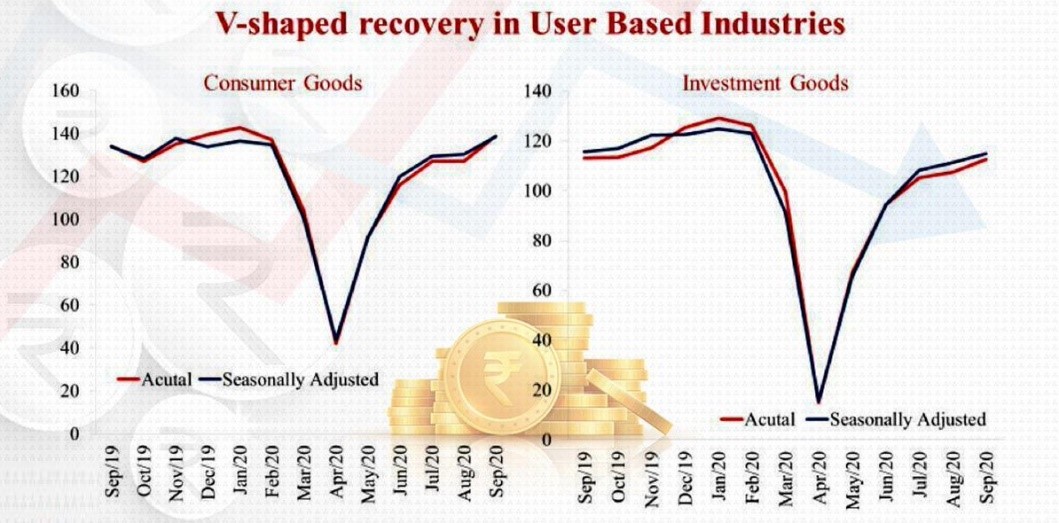
- Key indicators such as Services Purchasing Managers’ Index, rail freight traffic, and port traffic, are all displaying a V-shaped recovery after a sharp decline during the lockdown.
FDI
- Net Foreign Direct Investment (FDI) record the inflows of USD 27.5 billion during April - October, 2020.
- It is 14.8% higher as compared to the first seven months of FY 2019-20.
- Net Foreign Portfolio Investment (FPI) Inflows recorded an all-time monthly high of 9.8 Billion Dollars in November 2020.
- The services sector accounts for over 54% of India’s Gross Value Added (GVA) and nearly 4/5 of total FDI inflow into India.
- The Indian start-up ecosystem has been progressing well amidst the Covid-19 pandemic.
- India is being home to 38 unicorns.
- India’s space sector has grown exponentially in the past six decades.
- The allocated capital budget for defence has been fully utilised since 2016-17.
Agriculture and allied sector
- The Agriculture and Allied activities clocked a growth of 3.4%.
- The share of Agriculture and Allied Sectors in GVA of the country at current prices is 17.8% for the year 2019-20.
- In 2019-20, the major agricultural and allied export destinations were the USA, Saudi Arabia, Iran, Nepal and Bangladesh.
- The contribution of Livestock in total agriculture and allied sector GVA (at Constant Prices) has increased from 24.32% (2014-15) to 28.63% (2018-19).
- Fish production reached an all-time high of 14.16 million metric tons during 2019-20.
Innovation
- India has entered the top-50 innovating countries for the first time in 2020.
- Since the inception of the Global Innovation Index in 2007, India is ranked at first in Central and South Asia, and third amongst lower middle-income group economies.
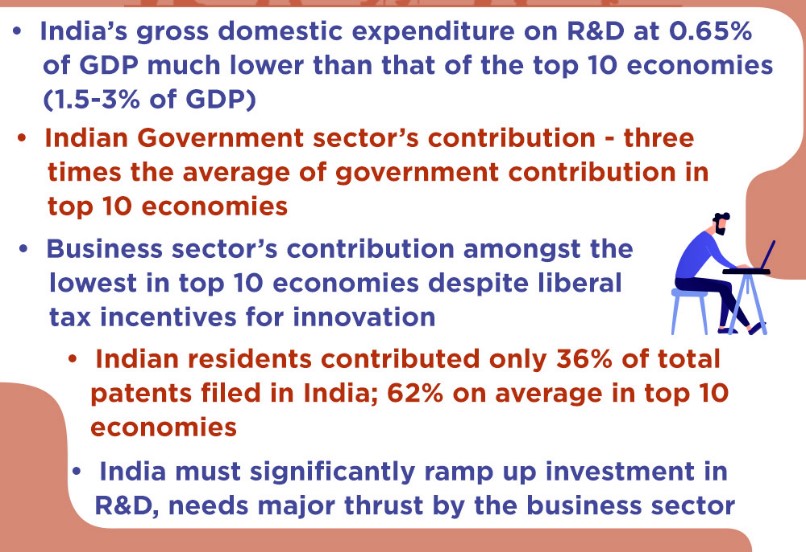
Credit ratings
- The fifth largest economy in the world has never been rated as the lowest rung of the investment grade (BBB-/Baa3) in sovereign credit ratings.
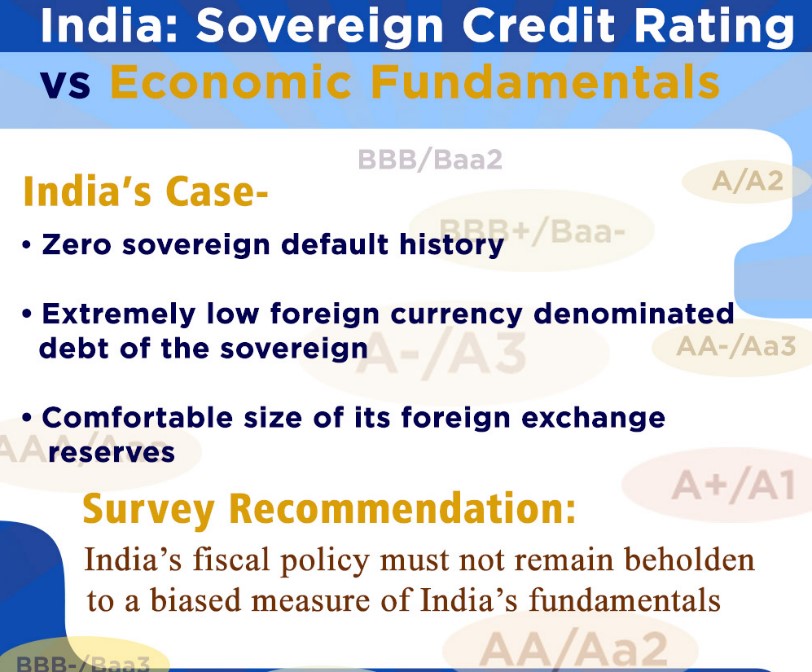
Health sector
- Pradhan Mantri Jan Arogya Yojana contributed to improvement in many health outcomes in many States.
- National Health Mission played a critical role in mitigating inequity as the access of the poorest to pre-natal/post-natal care.
- Institutional child deliveries increased significantly.
- An increase was seen in government spending on the healthcare sector – from the current 1% to 2.5-3% of GDP.
- The MANODARPAN initiative for psychological support has been included in Atma nirbhar Bharat Abhiyan.
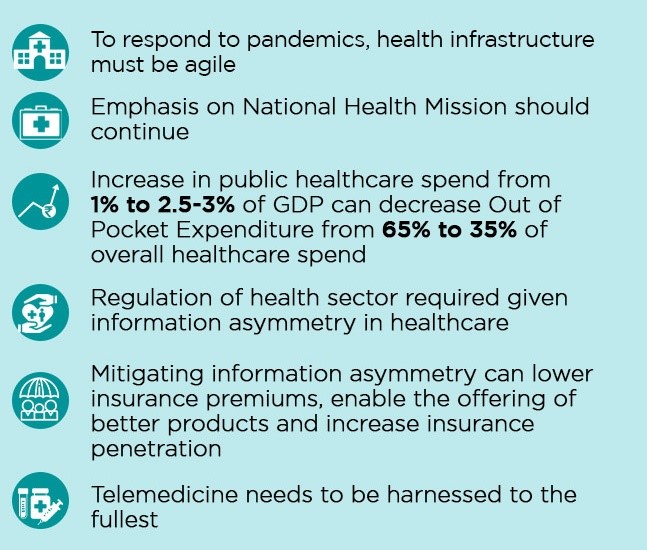
Literacy level
- India has attained a literacy level of almost 96% at the elementary school level.
- The literacy rate of persons of age 7 years and above at the All-India level stood at 77.7%.
- But the differences in literacy rate attainment among social-religious groups, as well as gender still persists.
- The percentage of enrolled children from government and private schools owning a smartphone increased enormously from 36.5% in 2018 to 61.8% in 2020 in rural India.
- PM eVIDYA is a comprehensive initiative to unify all efforts related to digital/online/on-air education.
- It aims to enable multi-mode and equitable access to education for students and teachers.
- Around 92 courses have started and 1.5 crore students are enrolled under Swayam Massive Open Online Courses (MOOCs).
- These are online courses relating to the National Institute of Open Schooling.
Initiative to education
- PRAGYATA guidelines on digital education have been developed with a focus on online/blended/digital education for students who are presently at home due to closure of schools.
- Vocational courses will be introduced phase-wise in schools for classes 9 to 12 to expose students to skill development avenues.
- It will part of the Centre's flagship skilling scheme Pradhan Mantri Kaushal Vikas Yojana 3.0.
BNI
- Bare necessities have improved across all States in the country in 2018 as compared to 2012.
- Bare Necessities Index (BNI) based on the large annual household survey data can be constructed using suitable indicators and methodology at district level for all/targeted districts to assess the progress on access to bare necessities.
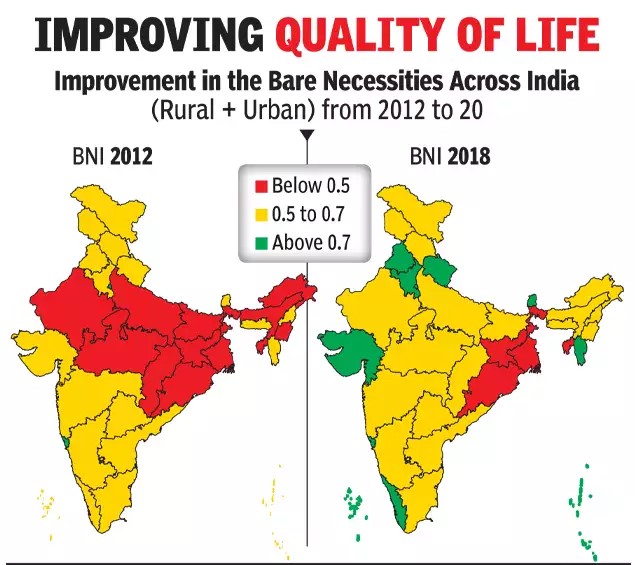
- The BNI summarises 26 indicators on five dimensions viz., water, sanitation, housing, micro-environment, and other facilities.
Social development and others
- The combined (Centre and States) social sector expenditure as Per Cent of GDP has increased in 2020-21 compared to last year.
- India’s rank in Human development Index (HDI) 2019 was recorded at 131, out of a total 189 countries.
- Government has given incentive to boost employment through Aatma nirbhar Bharat Rozgar Yojana and rationalization and simplification of existing labour codes into 4 codes.
- Females are spending disproportionately more time on unpaid domestic and caregiving services to household members as compared to their male counterparts (Time Use Survey, 2019).
- Both inequality and per-capita income (growth) have similar relationships with socio-economic indicators in India, unlike in advanced economies.
Work for SDG
- Voluntary National Review (VNR) was presented to the United Nations High-Level Political Forum (HLPF) on Sustainable Development.
- The localisation of SDGs is crucial to any strategy aimed at achieving the goals under the 2030 Agenda.
- Eight National Missions under National Action Plan on Climate Change (NAPCC) focussed on the objectives of adaptation, mitigation and preparedness on climate risks.
- India’s Nationally Determined Contributions (NDC) states that finance is a critical enabler of climate change action.
- World’s largest COVID-19 vaccination drive was commenced on 16th January 2021 using two indigenously manufactured vaccines.
- - - - - - - - - - - - -
Leave a Reply
Your Comment is awaiting moderation.


